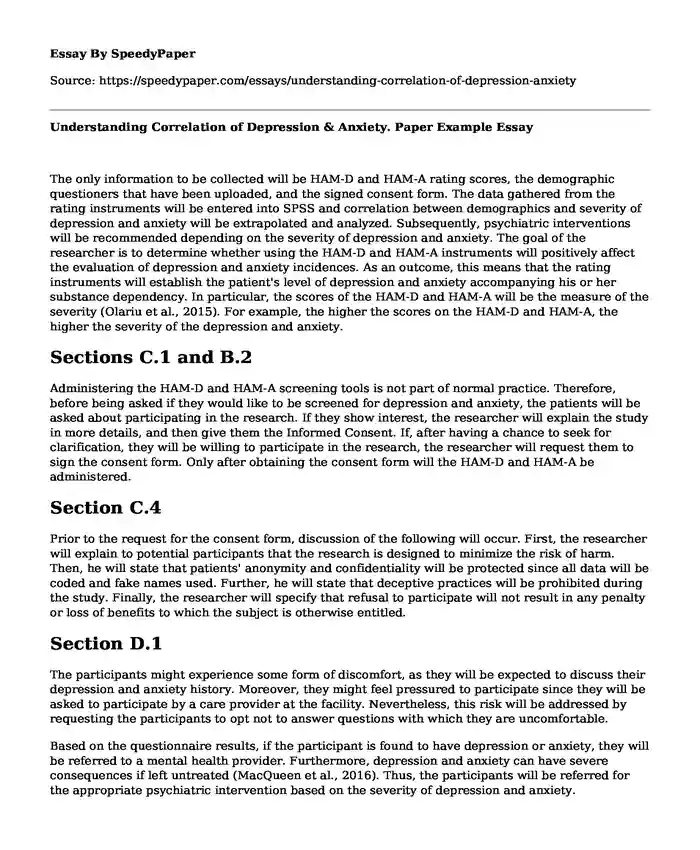
| Type of paper: | Research proposal |
| Categories: | Data analysis Depression Mental disorder Psychological disorder |
| Pages: | 3 |
| Wordcount: | 716 words |
The only information to be collected will be HAM-D and HAM-A rating scores, the demographic questioners that have been uploaded, and the signed consent form. The data gathered from the rating instruments will be entered into SPSS and correlation between demographics and severity of depression and anxiety will be extrapolated and analyzed. Subsequently, psychiatric interventions will be recommended depending on the severity of depression and anxiety. The goal of the researcher is to determine whether using the HAM-D and HAM-A instruments will positively affect the evaluation of depression and anxiety incidences. As an outcome, this means that the rating instruments will establish the patient's level of depression and anxiety accompanying his or her substance dependency. In particular, the scores of the HAM-D and HAM-A will be the measure of the severity (Olariu et al., 2015). For example, the higher the scores on the HAM-D and HAM-A, the higher the severity of the depression and anxiety.
Sections C.1 and B.2
Administering the HAM-D and HAM-A screening tools is not part of normal practice. Therefore, before being asked if they would like to be screened for depression and anxiety, the patients will be asked about participating in the research. If they show interest, the researcher will explain the study in more details, and then give them the Informed Consent. If, after having a chance to seek for clarification, they will be willing to participate in the research, the researcher will request them to sign the consent form. Only after obtaining the consent form will the HAM-D and HAM-A be administered.
Section C.4
Prior to the request for the consent form, discussion of the following will occur. First, the researcher will explain to potential participants that the research is designed to minimize the risk of harm. Then, he will state that patients' anonymity and confidentiality will be protected since all data will be coded and fake names used. Further, he will state that deceptive practices will be prohibited during the study. Finally, the researcher will specify that refusal to participate will not result in any penalty or loss of benefits to which the subject is otherwise entitled.
Section D.1
The participants might experience some form of discomfort, as they will be expected to discuss their depression and anxiety history. Moreover, they might feel pressured to participate since they will be asked to participate by a care provider at the facility. Nevertheless, this risk will be addressed by requesting the participants to opt not to answer questions with which they are uncomfortable.
Based on the questionnaire results, if the participant is found to have depression or anxiety, they will be referred to a mental health provider. Furthermore, depression and anxiety can have severe consequences if left untreated (MacQueen et al., 2016). Thus, the participants will be referred for the appropriate psychiatric intervention based on the severity of depression and anxiety. Additionally, a referral will be made to a psychiatric emergency room to protect the participants if they are found to be at significant risk from the consequences of depression and anxiety. Moreover, the researcher is a licensed psychologist and has the training and license to arrange to follow up as clinically indicated.
Section E.1
Any information obtained in connection with this research will remain confidential. All forms will be stored together in a locked safe to which only this researcher will have access.
Section E.2
No identifiers will be used for the data obtained. However, this researcher will instantaneously refer the patient for psychiatric follow up as indicated at the time of screening based on the HAM-D and HAM-A scores. Moreover, this researcher is a licensed psychologist and has the training to evaluate and refer to psychiatric patients as clinically indicated.
References
MacQueen, G. M., Frey, B. N., Ismail, Z., Jaworska, N., Steiner, M., Lieshout, R. J. V.& Ravindran, A. V. (2016). Canadian Network for Mood and Anxiety Treatments (CANMAT) 2016 clinical guidelines for the management of adults with major depressive disorder: section 6. special populations: youth, women, and the elderly. The Canadian Journal of Psychiatry, 61(9), 588-603. http://dx.doi.org/10.1177/0706743716659276
Olariu, E., Forero, C. G., CastroRodriguez, J. I., RodrigoCalvo, M. T., Alvarez, P., MartinLopez, L. M., ... & Fullana, M. A. (2015). Detection of anxiety disorders in primary care: A metaanalysis of assisted and unassisted diagnoses. Depression and anxiety, 32(7), 471-484. http://dx.doi.org/10.1002/da.22360
Cite this page
Understanding Correlation of Depression & Anxiety. Paper Example. (2022, Dec 28). Retrieved from https://speedypaper.net/essays/understanding-correlation-of-depression-anxiety
Request Removal
If you are the original author of this essay and no longer wish to have it published on the SpeedyPaper website, please click below to request its removal:
- Free Essay with Pete's Dragon Movie Review
- Free Essay Sample about Child Sexual Abuse
- Personal Essay Example: A Trip to Forget
- "Destiny of the Republic" Essay Sample
- Substantive Testing Versus Control Testing - Essay Example
- Free Essay Example - Market Depression
- Essay Example: Narcissism and Stalking
Popular categories




